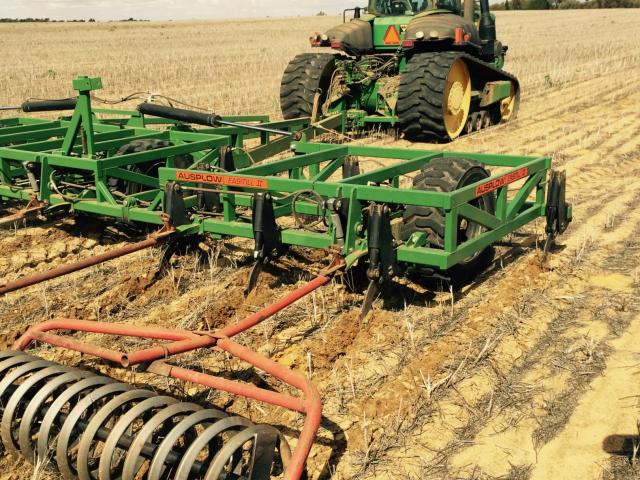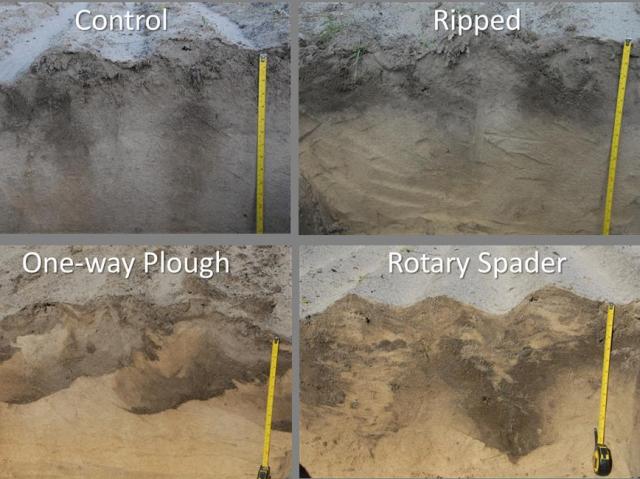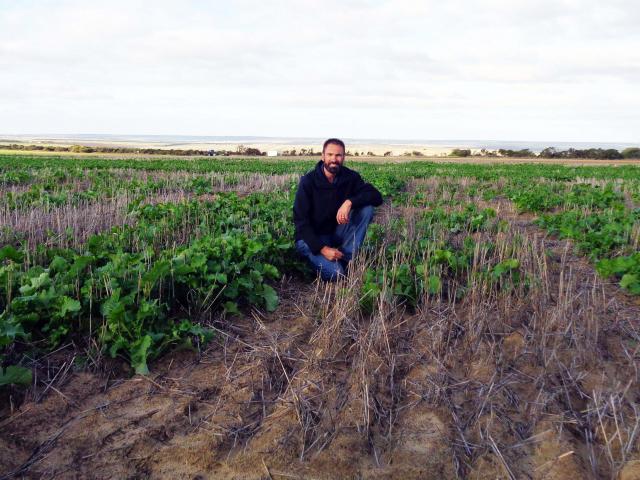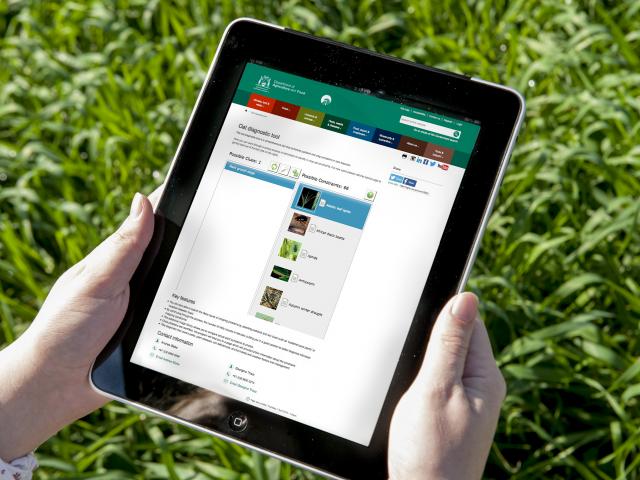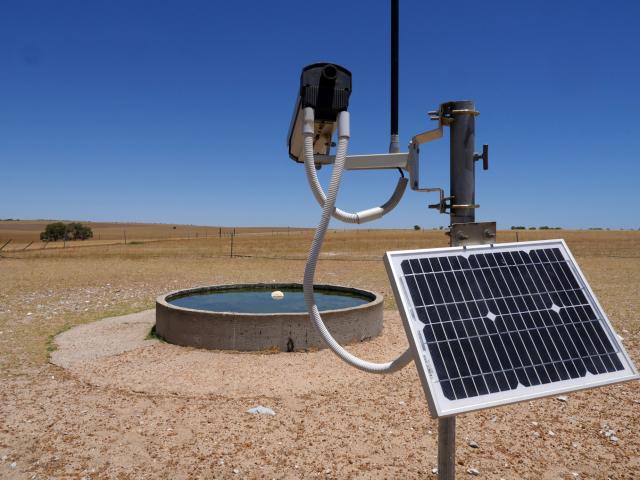Seeding into deep ripped or renovated soils
Achieving good plant establishment after soil renovation can be challenging depending on the resulting soil surface conditions.
Renovation techniques commonly used to address soil compaction and non-wetting soils that can be problematic include deeper deep ripping, mouldboard ploughing, spading or claying.
A survey last year conducted by the Department of Agriculture and Food, Western Australia (DAFWA) and the Mingenew Irwin Group (MIG) found 36% of farmers (out of 20) had issues with plant establishment after deep ripping.
Some of the problems noted by respondents included:
- bar castor wheels bogging.
- the bar sinking in lighter country, resulting in some wheat germinating from 125 millimetres in the deeper spots.
- uneven establishment; seeding in drying topsoil conditions increased erosion risk, therefore seeding ripped country was delayed until after rain.
- rollers were not heavy enough to lightly pack the surface (although melons and couch didn’t help).
Solutions used by survey respondents included:
- dropping the tyre pressure in the bar wheels.
- buying a bar with independent depth control.
- seeding at 45 degrees to the ripping direction, however this practice increases the area of the paddock re-compacted.
There is still further work to be done to determine the optimal management techniques for seeding into soft soil.
The following information suggests some current strategies to help reduce plant establishment issues.
Surface packing and finish
It is difficult to manage seeding depth if there is an uneven soil surface after ripping.
This can be compounded with the bar sinking into loose soil.
Towing a weighted roller behind the ripper helps produce a firm, even seed bed, breaking up any soil clods often produced when ripping heavier soil types.
There are some commercially available rollers or some farmers have designed their own.
Angle iron welded to large diameter steel pipe that can be filled with water to add weight or truck tyre rollers are just two variations in rollers manufactured to achieve a level surface.
Coil packers can help level the paddock after ripping although if ripping deeper than 30 centimetres or in moist conditions then a heavier weighted roller is likely to be required.
Many farmers have reported topsoil inclusion plates leaving large furrows in moist soil conditions, if these furrows cannot be removed by using a roller then it is advisable to take the plates off.
Rollers will affect the amount of stubble remaining standing so it is important to assess the erosion risk before ripping particularly in very sandy soils.
Wind erosion risk is reduced with 50% cover present at the beginning of autumn.
In very sandy soils with high erosion risk deeper ripping and topsoil slotting may provide a significant benefit by maintaining cover compared to the stubble burial achieved by mouldboarding and spading, however deep ripping is not a method to alleviate non-wetting.
Therefore if non-wetting is an issue on these soil types other management techniques may be required such as avoiding dry seeding, increasing seed rate or using a banded wetting agent.
Some farmers will choose not to rip paddock if stubble cover is considered too low.
The soil surface may also be left cloddy after soil renovation using a plough or claying particularly where subsoil with a higher clay content has been brought to the surface.
Some options to break up the clods include using a roller, prickle chain, disc harrows or offset discs.
If clods are particularly large offset discs may be the best option.
Surface crusting
Surface crusting is not usually a problem after deep ripping but it can occur with delving or after soil inversion using a mouldboard plough or spading.
Crusting can occur as a result of bringing up subsoil with higher clay content and burial of organic matter.
In the first season crusting can impede emergence.
Larger seeded crops (e.g. cereals, grain legumes) are better able to tolerate variations in seeding depth due to uneven surface following any tillage, however cereals have the greater capacity to recover from any wind erosion damage.
Herbicide activity
Herbicide activity can increase after soil inversion and deep soil mixing as result of reducing topsoil organic matter and water repellence.
While this may benefit weed control there can also be considerable crop damage from pre-emergent herbicides which can interact with seeding depth and other issues to reduce establishment.
Reducing herbicide rates and using safer pre-emergent herbicide options can significantly reduce this risk.
Seeding strategies
The following strategies have been found to help seeding into soft soils:
- Ground-following seeding equipment controlling the depth of each row with a press wheel-based mechanism can be an advantage seeding into uneven ground as the seeding depth is adjusted as required.
- Wider press wheels - may be required to reduce sinkage burying the seed deeper or reducing a bulldozing effect if the weight of the bar carried on the press wheels is too heavy.
- Light seeding bars - some growers who are undertaking large areas of deep ripping or soil amelioration have setup light seeding bars specifically for seeding soft soils, these are commonly 12 metres.
- Shallow working seeding points - can help minimise the sowing depth compared with deep working points. Some growers have even used worn or cut off knife points.
- Broadcast seed spreading - for soils that have been deep ploughed, broadcast spreading of cereal seed onto wet soil and then pressed down with coil packers can also be used for cover in the first year.
- Cross seeding - grower experience has shown seeding offset to the main working direction avoids plant establishment issues. However while this does show good results and may be required if all other strategies fail, if it can be avoided the return on ripping investment will last longer. Seeding at 45 degrees nearly doubles the trafficked area of the paddock and eighty percent of compaction occurs in the first pass. Before cross seeding consider why this option is needed; is it overcoming a non-wetting issue, high stubble load, or reducing bogging caused by bar design? Perhaps there are some management options that can be taken to avoid it in the future such as alleviate the non-wetting, modify the bar setting or change press wheels for example.
Wheel tracks
Deeper or rutted wheel tracks are another cause of variable seed placement.
This can occur in high traffic lanes that get deeper over time from multiple passes particularly in wet conditions, or where re-compaction post ripping has occurred by machinery if wheel tracks are not matched.
If the main bar wheels run in the depressed wheel tracks and there is no independent depth control the rows near the wheel track can be sown too deeply.
A similar issue can occur where the soil surface has lifted during the renovation process.
Maintaining wheel tracks by infilling the ruts will help reduce these issues and minimise the risk of erosion.
There are commercially available machines for renovating wheel tracks or some farmers have engineered their own.
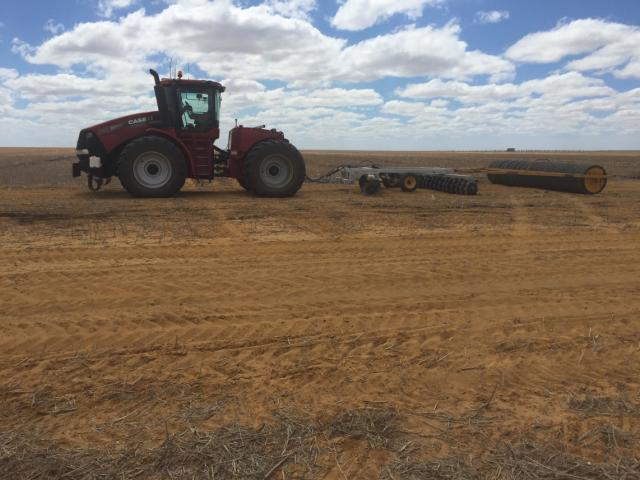
Bogging in soft soils after deeper ripping can be a problem that results in uneven seeding depth.
The problem is reduced if machinery is matched in a controlled traffic farming (CTF) system and the wheel tracks are not ripped.
However bogging can still occur if not all the machinery runs on the main wheel tracks, such as the bar or air cart wheels.
Reducing the tyre pressure in the bar wing wheels may help.
A possible strategy for air carts in very soft, boggy areas could be only half filling the cart and maybe reducing the tyre pressure in the front smaller tyres on tow behind carts.
Bogging may also be an issue for machinery that falls off the firm wheel tracks into wet soft soil particularly when travelling at faster speeds for spraying.
Some options include leaving a wider unripped wheel track, using wider tyres, or some farmers have found running a shallow ripping tine in line with the main wheel tracks forms a shallow channel that the sprayer can track in.
Conclusion
At the time of ripping or ploughing it is important to check the finish on the soil surface so adjustments can be made as you go to prevent challenges at seeding.
A poorly ameliorated soil can be very costly to fix.
More research is required to fine tune techniques to achieve good plant establishment after soil renovation to fully capitalise on the benefits of improved soil condition increasing plant root access to water and nutrients.
Acknowledgements
DAFWA’s GRDC funded projects DAW243 “Minimising the effect of compaction on crop yield” and DAW244 "Agronomic options for improved crop performance on water repellent soil in WA".
Mingenew Irwin Group GRDC RCSN project MIG00016-A "Deeper deep ripping and water use efficiency".
For more information contact:
- Bindi Isbister, Development Officer, Geraldton on +61 (0)8 9956 8532.
- Wayne Parker, Research Officer, Geraldton on +61 (0)8 9956 8511.
- Stephen Davies, Research Officer, Geraldton on +61 (0)8 9956 8515.
Below average winter rainfall forecast
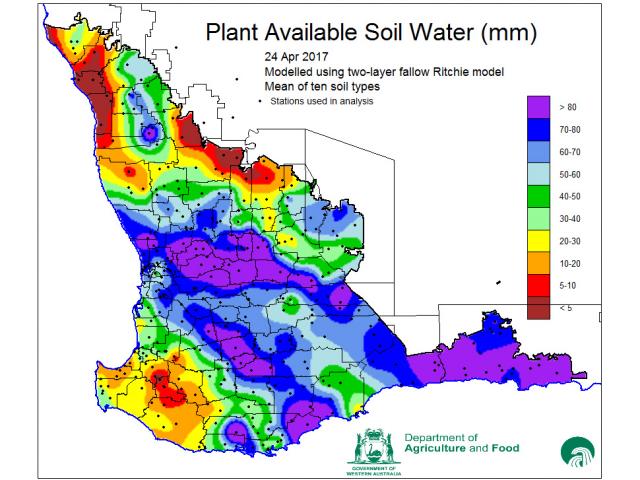
Western Australian grain growers have been advised to plan their 2017 cropping program carefully, with below average rainfall forecast during the growing season.
There is consistency between 10 out of 11 Australian and international climate forecasts, with none expecting wetter than normal conditions for April to June, suggesting greater confidence in the outlook.
Department of Agriculture and Food, Western Australia (DAFWA) Research Officer Meredith Guthrie said the strong agreement between models was unusual, especially early in the season.
The forecast is driven by the combined effect of a predicted El Nino event and the emergence of a positive Indian Ocean Dipole (IOD) by August, which is historically associated with below average rainfall.
In past years where an El Nino and a positive IOD have occurred together, the negative impact on rainfall became stronger in the South West and southern parts of Western Australia.
Department Research Officer David Ferris said the outlook for drier conditions, combined with varying amounts of sub-soil moisture across the regions due to widespread summer rainfall, could make it tricky for growers to roll out their cropping programs.
Currently, plant available soil moisture is less in the Northern Agricultural Region compared with the Central and South Coast Regions, where soil moisture levels are high.
Those areas with good soil moisture levels can still anticipate above average yields, in spite of the projected forecast for below average rainfall – provided crops emerge early or are sown into moist soils in May.
Growers who took the opportunity to deep rip compacted soils after summer rain will also benefit from crop roots accessing more of the soil profile this season.
Early, wet-seeding opportunities for canola have largely passed, as the soil surface has dried out, except where storms have occurred.
Canola growers should not to be tempted to chase soil moisture by seeding deeper than one centimetre, as results from early sown canola trials have consistently shown less emergence and lower yields with increased seeding depth.
With a drier than average outlook for April to June, growers in areas with limited stored moisture should manage their economic risk by delaying the bulk of nitrogen fertiliser applications until the season’s potential becomes clearer.
The department’s Statistical Seasonal Forecast (SSF) system is indicating a 30-60% chance of exceeding average rainfall across the grainbelt for the three months April to June.
The SSF indicates rainfall is most likely to be in the 2-3 decile range, the second lowest, based on a poor to good predictive skill (confidence in the forecast).
The Bureau of Meteorology’s current seasonal outlook is consistent, which predicts a 20-35% chance of exceeding average rainfall from April to June, based on a predictive skill of moderate to good.
The Bureau expects early season temperatures to be warmer than normal, with a 60-70% chance of above normal day-time maxima, based on moderate to good predictive skill.
The department has several free online cropping decision aids located on its Climate and weather page.
These include links to weather stations, rainfall to date tool, soil water tool and potential yield tool.
For more information contact:
Dr Meredith Guthrie, Research Officer (climate), South Perth on +61 (0)8 9368 3058.
Dr David Ferris, Research Officer (agronomy/farming systems), Northam on +61 (0)8 9690 2117.
Minimise early disease risks in your crops
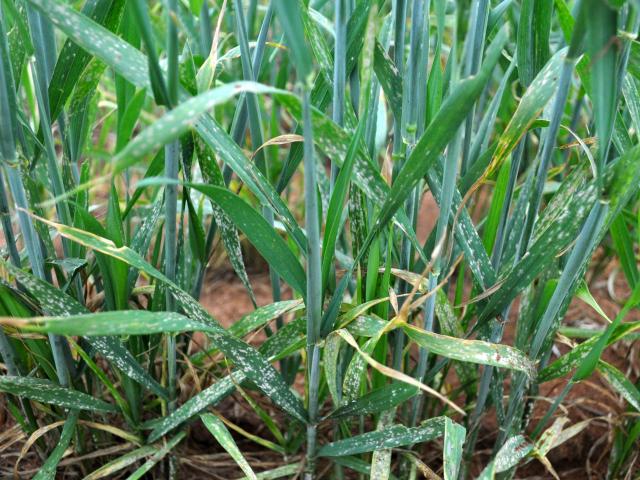
While waiting for the break of season, it is a good time to consider what pro-active management strategies you can employ to reduce early disease risks in your crops this season.
Summer rainfall created green bridge in some areas that may still remain and that could harbour disease or disease vectors (eg aphids).
The Department of Agriculture and Food, Western Australia (DAFWA) has some key tips to minimise your early disease risks:
-
Keep up to date with disease forecasts via the Crop disease forecasts page. Forecasts are currently available for canola blackleg, field pea blackspot and field pea seed borne mosaic virus.
-
Check out the PestFax map showing what diseases were reported from your area last season to give you an idea of what diseases might be a higher risk this season. Be sure to subscribe to the pestfax newsletter if you haven’t already to receive information on pest and disease finds across the WA wheatbelt this season. Pestfax has commenced for this season and powdery mildew has been reported on volunteer wheat in the Esperance region.
-
Protecting WA Crops is DAFWA’s new monthly eNewsletter providing agronomists and growers with an up-to-date review of the weed, disease and pest threats that impact on crop production. It is a rebranding of the E-weed newsletter.
-
Control green bridge - It is crucial to destroy any volunteer cereals and weeds at least 4 weeks prior to seeding to reduce risk of early rust, powdery mildew and wheat streak mosaic virus (WSMV) infection in your new crop this season. Weeds can also carryover other crop diseases such as grassy weeds and volunteers hosting root or crown diseases and root lesion nematodes.
-
Plan variety choices and crop rotations to minimise disease risks: Understand the factors contributing to disease risk in each paddock (eg. stubble, soil borne inoculum) to determine if that will influence your crop or variety selection for that paddock or adjoining paddocks this season. Be aware of the major diseases associated with each crop and variety in your area - give preference to varieties with some disease resistance. Crop rotation or removal, incorporation or burning of stubble can reduce risk of stubble borne diseases: canola blackleg, Fusarium crown rot, field pea black spot, barley net blotch, scald wheat yellow spot, wheat septoria nodorum blotch, powdery mildew in wheat or barley. Crop rotation is also effective for managing soil borne diseases and pests such as Rhizoctonia bare-patch, take-all, and root lesion nematodes. Sclerotes of Sclerotinia stem rot in canola, lupins, chickpeas and lentils can survive in soil for up to 6 years so non-host species (such as cereals) should be grown for at least 3 years in paddocks that were recently affected to reduce disease risk. Find out more crop specific disease management, research results and the disease ratings of different varieties on the Crop Disease webpage of the DAFWA website.
-
Soil test for root diseases and nematodes if you observed any uneven growth or bare patches in your crops last year. For more information see Root diseases under intensive cereal production systems and Root lesion and burrowing nematodes in Western Australian cropping systems.
-
Consider seed or in-furrow fungicide treatments registered for the diseases your crop could be at risk from (including smuts, and foliar and root diseases). Remember in-furrow fungicides will not control smut diseases. Information on registered seed dressing and in-furrow fungicides for cereals is available on the DAFWA webpage.
-
In the absence of seed or in-furrow fungicides, crop monitoring is very important to identify disease risks. Early foliar fungicide application applied in a timely manner can be effective. Information on registered foliar fungicides for cereals is available on the DAFWA webpage.
For more information contact:
Plant Pathologists - cereals
Ciara Beard, Geraldton on +61 (0)8 9956 8504.
Geoff Thomas, South Perth on +61 (0)8 9368 3262.
Andrea Hills, Esperance on +61 (0)8 9083 1144.
Kith Jayasena, Albany on +61 (0)8 9892 8477.
Plant Pathologists - canola
Ravjit Khangura, South Perth on +61 (0)8 9368 3374.
Root diseases
Daniel Huberli, South Perth on +61 (0)8 9368 3836.
Nematodes
Sarah Collins, South Perth on +61 (0)8 9368 3612
Deep ripping no guarantee to fix water repellent soils
Grain growers who have taken advantage of summer rainfall and deep ripped paddocks have been warned the practice does not necessarily overcome soil water repellence.
While deep ripping was an effective way to reduce soil compaction, it did not guarantee improved soil water infiltration.
In some cases, deep ripping could exacerbate topsoil water repellence.
Deep ripping does not alter the soil surface condition, only the subsoil condition.
In fact, ripping when the repellent topsoil is quite dry can make expression of the repellence worse.
Dry sown crops can sometimes have worse establishment on strongly water repellent soils that have been deep ripped, with poorer water infiltration when the dry topsoil has been loosened.
An on-farm demonstration trial with the Mingenew-Irwin Group in 2016 found there were far greater gains to be made by soil inversion treatments, than deep ripping, when it came to overcoming soil repellence.
The soil moisture content on 25 May after soil inversion or rotary spading treatments was 100% higher than the control at 10 centimetres, 50-80% higher at 20cm and 10-40% higher at 30cm.
By comparison, three deep rippers were also tested but did not have a significant benefit on infiltration and soil moisture content.
Growers who had deep ripped strongly water repellent soils may want to implement cropping strategies to aid crop establishment.
Options include avoiding dry seeding and seeding cereals later on these soils, once there has been good rainfall.
Other options include increasing the seeding rate, using a banded soil wetting agent – either applied on the surface of the furrow or banded near the seed – or using other soil amelioration measures to address severely impacted areas.
Research by the Department of Agriculture and Food, Western Australia (DAFWA) has found the use of a rotary spader or mouldboard plough can generate significant benefits to soil quality and subsequent yields on strongly repellent soils.
Trials at Badgingarra and Esperance over the past five years on strongly water repellent soils revealed that inverting the soil through these processes have decreased repellency to zero, which has increased cereal grain yields by 0.4 to 1.2 tonnes per hectare.
Department research on soil water repellent soils will continue this year, including the continuation of three trials at Irwin, Marchagee and York.
These trials will examine the impacts of deep ripping on water repellent soils and whether there is a positive interaction with soil wetters to help ensure good crop establishment.
It was difficult to draw a conclusion from the trials in 2016, as it was a wet year, which produced reasonable establishment and variable results in response to the deep ripping and soil wetters.
At the Irwin site, deep ripping with topsoil slotting increased wheat grain yield by 0.6t/ha, while at a Watheroo site, soil wetters increased yield by 0.1-0.2t/ha but ripping resulted in a small yield reduction.
More information about soil water repellence is available on the Soil water repellence webpage of the DAFWA website.
For more information contact Stephen Davies, Research Officer, Geraldton on +61 (0)8 9956 8515.
Trials show depth counts for canola
Department of Agriculture and Food, Western Australia (DAFWA) trials have revealed shallow sowing canola improves crop establishment and yields.
Recent work through the Tactical Break Crop Agronomy project evaluated the value of chasing moisture in a drying topsoil by deeper sowing canola.
Trials at Eradu, Mingenew, Merredin and Dalwallinu compared a range of sowing depths.
The results were very clear. Even when sowing in April, into drying soil, the establishment of canola was better at 1 centimetre depth, compared to 3cm or 7cm.
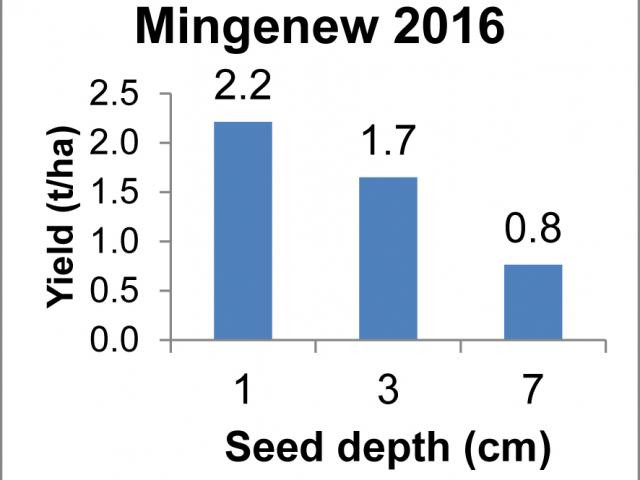
Sowing at 3cm resulted in an average yield loss of 19%, when compared with sowing depths of 1cm.
There were further losses with very deep sowing at 7cm, with an average reduction of nearly one tonne/hectare.
It is expected the yield loss results apply over the agricultural region, including southern areas.
A range of seed sizes were used in the trials and losses were sometimes exacerbated where small canola seed was used.
In the 2016 Mingenew trial, using small seed (370 000 seeds/kilogram) from open pollinated (OP) varieties reduced establishment, yield and gross margin compared with larger OP seed (230 000 seeds/kg).
There was a similar effect at the Eradu trial, but only where seed was sown deep.
Hybrid varieties’ seed establishment was better than OP.
This has also been reported in other trials, and has been attributed to the larger seed size of the hybrid.
Seeding and emergence is the most vulnerable stage for canola so it is important to get the right depth, seed quality and seeding rate.
Check your seed depth, make sure to get a germination test for any retained seed and calculate your best seeding rate.
The canola seeding rate calculator is available from the DAFWA website along with more information to optimise canola seeding rates.
The work was done by department research officers Martin Harries, Dr Bob French and Sally Sprigg, as part of the department’s Tactical Break Crop Agronomy project, supported by the Grains Research and Development Corporation.
For more information contact Martin Harries, Research Officer, Geraldton on +61 (0)8 9956 8553.
MyCrop diagnostic apps a must for the growing season
Growers and agronomists are reminded to download the MyCrop diagnostic apps before the growing season.
Developed by the Department of Agriculture and Food, Western Australia (DAFWA) these apps can be used to diagnose and overcome constraints in broadacre crops thereby optimising yield potential.
MyCrop includes a range of interactive tools to help overcome constraints to production in wheat, barley, canola, lupins, oats and field pea crops.
The MyCrop diagnostic apps and other tools and can be accessed on the DAFWA website.
Separate apps are available for wheat, barley, canola, oats and pulses (lupins and field peas) and can be downloaded from iTunes or Google Play directly to tablets and mobile phones for use in the field.
The MyCrop diagnostic tool enables growers to use a process of elimination to identify and treat crop constraints.
MyCrop is very easy to use, growers simply select from a range of paddock and soil clues to identify the likely cause of their problem, such as pests, diseases, soil deficiencies, environmental and weather factors.
The MyCrop tool includes an extensive library of images allowing growers to compare in-paddock crop symptoms with high quality photographs depicting crop constraints.
Once the problem is identified, growers can then link into further information about how to overcome the constraint.
Each of the apps includes a link that can be used to log the occurrence of pests and diseases directly to the department’s PestFax Map database.
Users can also access the MyCrop diagnostic tools via the MyCrop page of the DAFWA website without a mobile device.
The suite of MyCrop apps, which was developed by the department with support from the Grains Research and Development Corporation (GRDC) has had more than 4000 downloads since its inception in 2013.
The free apps do not require the internet to function once downloaded.
For more information on the apps or the MyCrop project please contact Andrew Blake, Development Officer, Geraldton on +61 (0)8 9956 8564.
Response to exotic plant pest continues
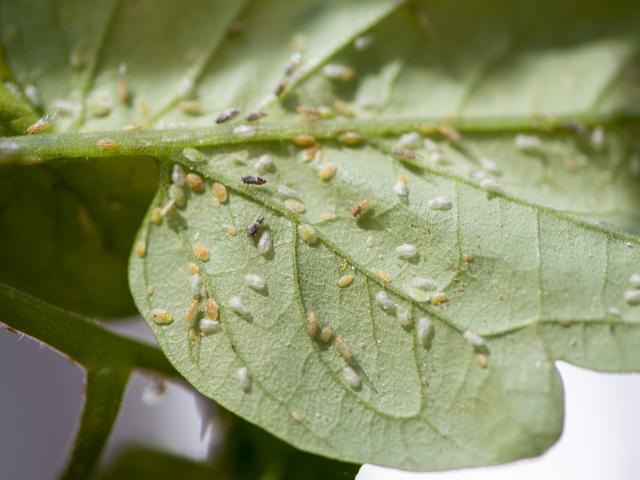
The Department of Agriculture and Food, Western Australia (DAFWA) is working with the State’s horticulture industry on a management plan to combat tomato potato psyllid, following a national decision that it cannot be eradicated in Australia.
The damaging insect pest was detected in Western Australia (WA) for the first time in February, prompting a national biosecurity response.
It has not previously been found in Australia.
Tomato potato psyllid attacks a range of vegetable crops in the Solanaceae family including potato, tomato, eggplant, capsicum, chilli, tamarillo and sweet potato.
Over the past three months, the department has had more than 130 staff working on the response and has carried out extensive trapping and surveillance throughout Perth and the State’s horticulture production regions to check for the pest and take measures to stop it spreading.
The department commends industry and the community for their efforts in this response as we continue to examine the best way to manage this pest and support growers into the future.
Surveillance
Since the initial detection, close to 8000 surveillance ‘sticky’ traps were installed in regional and metropolitan areas and inspections carried out on more than 1400 properties across the State, including more than 530 commercial horticulture and retail properties.
The psyllid was found on more than 70 properties and is now considered to be quite widespread in the metropolitan area.
There were also 18 psyllid infected properties found outside the metropolitan control area, all of which have now been treated.
As part of the response, the department has collected thousands of plant samples and tested for the associated bacteria Candidatus Liberibacter solanacearum (CLso) which can be carried by the psyllid, and is a threat to our potato and horticulture industries.
The bacteria is not a threat to animal or human health.
More than 8800 plant samples were tested for the CLso bacteria, and more than 30 000 potato tuber samples screened for zebra chip disease.
There have been no detections of the bacteria to date.
Transition to management
The National Management Group agreed that it was not technically feasible to eradicate tomato potato psyllid, and supported transitioning to a management program.
The department is working with industry and national partners on a 12-month management plan, which will focus on control options on farm, supply chain management and restoring access to interstate markets for affected produce.
This work includes identifying key areas for further research to improve management outcomes and market access.
Over the month of May, there will be concentrated trapping for the psyllid in the metropolitan control area to test for the CLso bacteria where higher populations of the psyllid exist and again in Spring.
This will build confidence that CLso is not present in WA.
Existing quarantine and movement controls in WA remain in place for now to minimise the risk of spreading the psyllid within the State.
Check and report
To assist in WA’s surveillance efforts, the department needs help from:
- Commercial vegetable growers to check for signs of the psyllid and report via the MyPestGuide Reporter app available from the Google Play or the App Store. Alternatively, email photos with your name, address and mobile number to info@agric.wa.gov.au, or call the Pest and Disease Information Service on 1800 084 881.
- Home and community gardeners who suspect they may have TPP should send a photo to DAFWA via the MyPestGuide Reporter app, or email photos to info@agric.wa.gov.au. Alternatively, call the Pest and Disease Information Service on 1800 084 881. For more information on how to check the garden, please view the ‘How to check my vegetable patch’ video.
Restrictions on interstate trade
The department has established a market access team to develop protocols with other states to help facilitate interstate trade for Western Australian produce which has been restricted as a result of the psyllid detection.
New South Wales, South Australia, Victoria, Queensland and the Northern Territory have emergency interstate movement controls in place for the psyllid and CLso host fruit, vegetables and plant material, and used machinery and equipment from WA.
NSW, Victoria and South Australia have introduced additional restrictions on a much broader range of conditional non-host plants and produce.
Full details of the entry conditions are updated on the NSW, Victorian and South Australian department websites.
Exporters should contact the Quarantine WA Exports Officer to verify export requirements:
More information is available from the Tomato Potato Psyllid page on the DAFWA website
About TPP
Tomato potato psyllid is a tiny sap-sucking insect with three stages of development – egg, nymph and adult. Adults and nymphs of tomato potato psyllid cause injury to plants by feeding with sucking mouth parts.
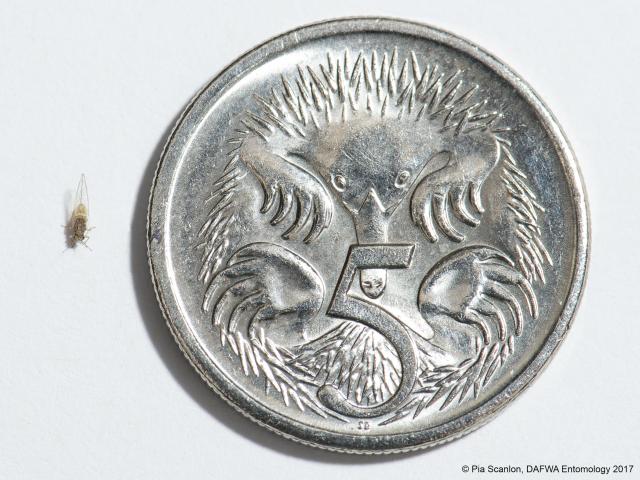
Look for the insect in all its life stages on the underside of leaves.
Signs of TPP include:
- insects jumping from the foliage when disturbed
- white sugar-like granules which coat the plant leaves and stems, and can lead to the development of sooty mould
- yellowing of leaf margins and upward curling of the leaves
- severe wilting of plants caused by high numbers of psyllids feeding
- shortening of stem internodes
- stem death similar to other potato and tomato disorders.
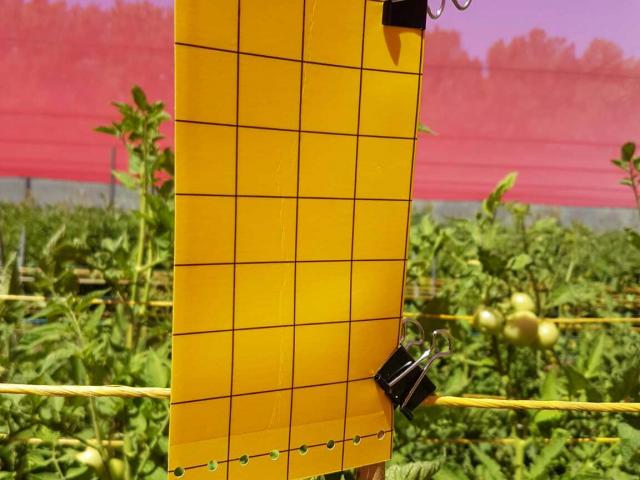
Biosecurity reminders
- Good farm biosecurity procedures should be in place to prevent the entry, establishment and spread of pests and diseases.
- Practice sound crop hygiene/biosecurity practices to prevent the entry, establishment and spread of pests and diseases.
- Proper signage to restrict entry, routine surveillance for pests, on-farm clean down facilities, and action plan and checklist are all part of a farm biosecurity regime.
- The weeds nightshade, groundcherry, matrimony vine, and field bindweed are also hosts of the pest and management of these should be considered.
- More information on biosecurity is available at the Farm Biosecurity website.
- Additional resources include the AUSVEG Farm Biosecurity Plan.
Further information
More information, including how to look for and report the pest, the latest Industry update and details on the Quarantine Area Notice, are available on the Tomato Potato Psyllid page.
Department of Agriculture and Food, WA
Rohan Prince, Industry Liaison
Phone: +61(0)8 429 680 069
Email: rohan.prince@agric.wa.gov.au
Pest and Disease Information Service
Phone: 1800 084 881
Email: info@agric.wa.gov.au
Using remote cameras to monitor water
On properties where sheep access water using troughs, checking the troughs during summer – autumn can be a time-consuming process.
There is also a cost associated with fuel, wear and tear on vehicles and labour used in checking troughs not being available for other farm improvement tasks.
The labour cost is often the most significant if it means other things can be missed on farm and staff can’t go away from the farm for more than a couple of days at a time.
Remote monitoring cameras
Where sheep are being run over multiple properties which are a significant distance from the home base, remote monitoring cameras on water troughs are a handy tool.
Using the mobile phone network, remote cameras allow the user to remotely monitor a number of troughs using an app on their device by logging in with a secure username and password.
The cameras can be set to take regular photos on a schedule.
If mobile reception is not available then a satellite phone connection is possible.
Remote cameras with a solar panel and aerial can be purchased for around $1500 each.
They are portable and can be easily shifted around when a mob is moved to another paddock.
The economics
DAFWA have had a benefit-cost analysis done on a sheep enterprise near Eneabba.
Over a ten year period, a system comprising 15 remote cameras cost $22,500 but saved the farmer $21,400 every year in labour and vehicle costs.
This saving was the result of not having to do a 300 – 400km round trip every three days during summer.
The benefit-cost ratio for the cameras was 5.3, so for every dollar invested in remote cameras, there was a saving of $5.30.
The payback period for the investment is 2 years.
One of the factors determining the profitability of the investment is the distance travelled.
There is a break even in the investment (benefit-cost ratio of 1) when 5km is travelled.
So investment in remote cameras can still be profitable where distances of 5km or more are travelled when inspecting troughs.
A key benefit of the remote cameras which is not captured by the economic analysis is the ‘peace of mind’ when away from the farm and better time management when home on the farm.
Further information
New on – farm technology to improve labour efficiency is a focus in the Sheep Industry Business Innovation (SIBI) project.
We will be producing a series of case studies on specific tools to improve labour efficiency.
A short video on the remote cameras is available on the DAFWA Youtube channel.
The economic analysis and feature article on the case study is available on the SIBI new on-farm technology webpage.
For more information contact John Paul Collins, Research Officer, Katanning on +61 (0)8 9821 3249.
State Horticulture Forum explores opportunities for growth
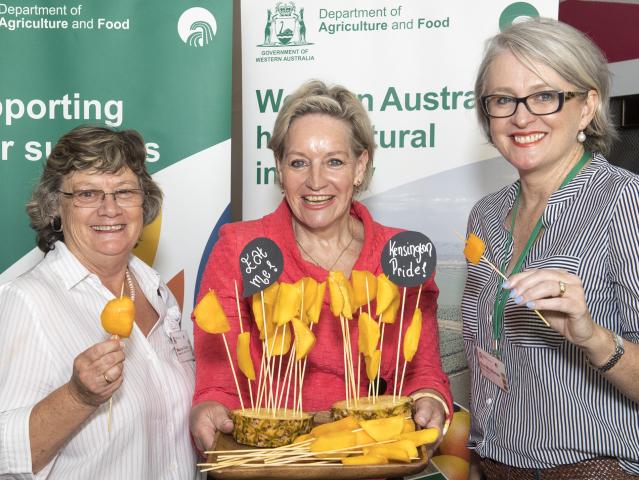
Western Australia’s inaugural State Horticulture Update attracted a strong crowd, keen to hear about the latest issues, case studies and expertise in this growing industry.
More than 120 people attended the Update in Perth in early April, drawing supply chain participants from throughout the State.
The Department of Agriculture and Food, Western Australia (DAFWA) hosted the event, to explore strategies and information to assist WA horticulture businesses to become internationally competitive.
The gathering was privileged to hear from new Agriculture Minister Alannah MacTiernan, who acknowledged the value in investing in the industry to capitalise on new market opportunities and generating regional jobs.
A highlight of the day was a presentation on the Coriolis consultancy’s Pathways to competitiveness report by director Tim Morris.
The report was commissioned by DAFWA, as part of its Agricultural Sciences project, funded by Royalties for Regions to identify opportunities, constraints and drivers for growth and investment that characterise successful, internationally competitive agribusinesses.
The analysis provided key insights for industries to achieve more viable international pathways.
There are some interesting lessons to be learnt from peer regions that have transformed relevant industry sectors over a relatively short period.
Agrifood growth in Peru, the dairy industry in New Mexico and pork industry growth in Chile all provide strong examples of transformation and global competitiveness.
Members of the State’s potato and citrus industries, which have been assessed and benchmarked against peer regions that are achieving international success, will find this report interesting.
DAFWA is committed to assisting the horticulture industry to double its value by 2025.
Our role is to grow and protect WA’s agrifood sector, working in close partnership with the agrifood sector to achieve this.
As an economic development agency, underpinned by science, innovation and commercial awareness, DAFWA is well placed to deliver on government’s priority to grow the sector’s contribution to the State economy and protect its enviable biosecurity reputation and competitive advantage.
DAFWA has been supporting the development of irrigation developments in the State’s north by identifying suitable available water and land, to ground truth resources for potential investors.
Royalties for Regions projects have identified more than 60,000 hectares of suitable land for irrigation in the La Grange are in the West Kimberley, while more than 10,000ha of land at Cockatoo Sands in the East Kimberley are capable of delivering new industries.
More than 400 hectares of new land near Carnarvon has been confirmed for expansion as part of the Gascoyne Food Bowl initiative, while the department has also identified growth zones at Myalup, where there is potential for significant expansion in irrigated agriculture.
The department is also working on the Department of Water’s Water for Food Royalties for Regions projects in the West Midlands, Southern Forest, Preston and Collie-Wellington areas to explore potential for increasing irrigation development.
Several department officers also updated the forum on a major emergency response to the discovery of the exotic pest tomato potato psyllid, which is a serious pest to vegetable production, and its impact on market access.
Another feature of the Update was an overview of the development of a marketing campaign for the Bravo™ apple and insights by local business leaders on business growth, export approach and the challenges of taking businesses to the next stage.
WA’s horticulture industry has a production value of $702 million (2014-15), with exports worth $158 million.
In the past 12 months fruit exports have increased by 23%, while vegetable exports have increased by 17%.
The industry’s value added contribution to the economy is significant, amounting to about $1.6 billion.
While horticulture represents less than 10% of the gross value of agricultural production, it accounts for more than 25% of employment at a farm level.
In terms of value adding the value of horticulture increases on average 3.3 times from farm to consumer, with wine the biggest contributor.
The State Horticulture Update also featured success stories from Sue Middleton from Moora Citrus, Maureen Dobra from the Loose Leaf Lettuce company, while the Western Citrus Alliance the PomeWest provided insights in the current market constraints and opportunities.
For more information about the Department of Agriculture and Food, Western Australia’s work in irrigated agriculture visit the Horticulture webpage on the DAFWA website.
For the State Horticulture Update program, and link to the pathways to competitiveness report visit the State Horticulture Update webpage.

